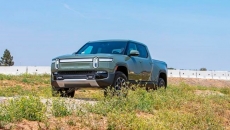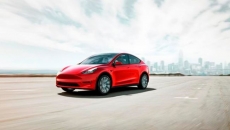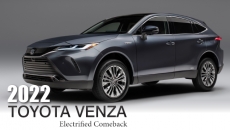The Ford F-150 Lightning and Tesla Cybertruck are two intriguing options for someone thinking about buying an electric pickup truck. They could also hardly be more different. The Lightning looks and drives much like a traditional gas-powered F-150. The Cybertruck, in contrast, looks like nothing else and ignores convention with its stainless steel body and square-shaped steering wheel. Yet both trucks are capable of towing a trailer, hauling a bunch of gear, or taking the family out to dinner. Which one is the better all-around truck? Edmunds’ car experts tested them to find out.
Power, range and charging
Tesla currently offers two Cybertruck versions: a 600-horsepower All-Wheel Drive model with an estimated driving range of up to 340 miles and the 845-horsepower Cyberbeast that provides a 301-mile driving range. An optional range-extender battery pack adds about 135 miles of range but reduces cargo space because it’s mounted in the bed.
The Lightning is available with a standard-range battery pack that delivers 452 horsepower and a range of 240 miles. With the larger extended-range battery, power is boosted to 580 horsepower, and range increases to up to 320 miles. In testing, Edmunds has found acceleration and range to be very similar for the two trucks. The All-Wheel Drive Cybertruck and upgraded Lightning accelerated from zero to 60 mph in 4 seconds flat and managed to go more than 330 miles in the Edmunds EV Range Test.
Charging is where the Cybertruck pulls ahead. It can charge more quickly at high-powered fast-charging stations and has full access to Telsa’s nationwide network of Supercharger stations. Essentially, charging can be more convenient and take less time when you’ve got a Cybertruck.
Winner: Cybertruck
Towing and payload
Both Cybertruck models have a towing capacity of 11,000 pounds and a payload capacity of 2,500 pounds. The F-150 Lightning’s towing capacity maxes out at 10,000 pounds, and its payload capacity is 2,235 pounds with the standard-range pack and 1,952 pounds with the extended-range pack.
Although the Lightning’s numbers are slightly lower, it can still handle towing a midsize boat or hauling an ATV in the bed. The Lightning also offers several towing and hauling features the Cybertruck lacks such as Onboard Scales and Smart Hitch. The former estimates your payload weight, and the latter estimates the tongue weight of the trailer.
Winner: Lightning
Interior and tech
Ride quality is one of the Cybertruck’s strengths. It’s very smooth even over rough surfaces. The front seats are comfortable but the rear seats are pretty stiff, and it doesn’t offer as much passenger space as the Lightning. The Lightning’s ride quality and seat comfort are also excellent but one notch below the Cyerbtruck’s. The Lightning, however, gets points back for having easy-to-use interior controls, significantly better outward visibility, and more available luxury features like massaging seats.
Almost everything in the Cybertruck is controlled by the massive 18.5-inch center touchscreen. It looks great and is responsive, but using certain controls while driving can be distracting. The electric truck also lacks full smartphone connectivity such as Apple CarPlay and Android Auto. The Full Self-Driving package, which includes a long list of advanced driver aids that can automatically accelerate, brake and steer the truck, is standard. However, it’s not actually a self-driving system. The driver must pay attention and intervene when needed. The package is currently only available to a select number of owners.
The Lightning offers a slew of tech features including a sizable 15.5-inch center touchscreen, more smartphone connectivity options and many advanced driver aids. Ford’s BlueCruise, a hands-free driving system that works on many highways, is available.
Winner: Lightning
Pricing and value
The Cybertruck All-Wheel Drive has a starting price of $102,235, including destination. The more powerful Cyberbeast is $122,235. Tesla has promised a less expensive Rear-Wheel Drive model but we’re not expecting it to be available until next year. Excluding the commercial-oriented Pro version, pricing for the Lightning starts at $65,090 for the XLT trim and $87,090 for the top Platinum trim.
Until the Rear-Wheel Drive model becomes available, or if Tesla reduces pricing, the Cybertruck makes the Lightning look like a steal. It’s hard to justify the $40,000 price difference between the base models. And even though the Cyberbeast is more powerful, the significantly less expensive Platinum trim offers much more value thanks to its long list of luxury, tech and towing features.
Winner: Lightning
Edmunds says
The Lightning is the winner because it offers more value, more towing tech, and a larger and more practical interior. But if you want a truck with a design that will turn more heads than a Ferrari, then the choice is obvious.






